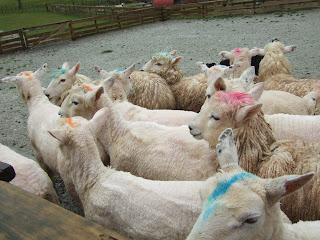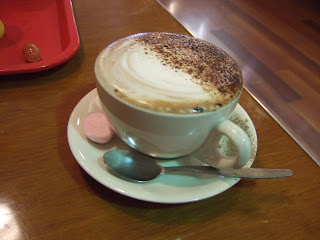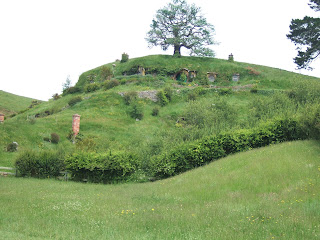Travel Dates: December 2, 2012 to December 4, 2012
We were very happy to find a Thai restaurant and return to Asian food after 10 days of rich French creams and sauces. During our stay in Downtown Hamilton, we frequented the joint for some hot noodle soup to soothe the soul.
We also had breakfast at a lovely little cafe that serves great hot chocolate.
Hamilton was all decked out and ready to celebrate a warm Christmas. Unfortunately, this was where Tung punched out for a 24-hour battle with fever and chills as food poisoning from French Polynesia finally got the better of him. Luckily, we were within walking distance of a nearby walk-in clinic. After duking it out for a day and a half, Tung was ready to hit the road again.
Why? He couldn't possibly stand to miss Hobbiton in Matamata, the whole point of us going to New Zealand in the first place, before we had to drive back north to Auckland. After an unreliable GPS moment and flagging down a postal worker to help us find the way, we made it at last.
 |
| Carved stone depicting Frodo and Sam climbing uphill |
Hobbiton was built on an actual farm, a 1,250-acre estate belonging to the Alexander family, who still live and farm there today. We got to see cows being herded to the pasture for grazing as we arrived for one of the earliest tours in the day.
 |
| 300 cattle on the Alexander Farm |
 |
| 13,000 sheep on the Alexander Farm, all sheared by the Alexander brothers every 8 months. Here, the woolies graze in an enclosed pasture. |
The azures and turquoises of French Polynesia gave way to the emerald- and apple-greens of a New Zealand countryside, and I am still in awe at the rich spectrum that nature gifts us. Hobbiton as a movie set was most impressive--real props and rustic, gravel-lined roads transport you to another age and time as you set foot in this quaint little town. With all its natural beauty, it definitely beats the more facade-like environment at Universal Studios.
This was the very first hobbit house that we saw on the tour. There are 44 unique hobbit holes! At the time of the filming of
The Lord of the Rings, catering had to be brought in for 400 cast and crew, three 2-course meals a day.
This is the house of Samwise Gamgee, Frodo Baggins's faithful sidekick. Sam was Frodo's gardener in Hobbiton, so his house is carefully manicured with English-native flora.
I am about a fitting size for a hobbit hole! Highly considering Tung's suggestion to move to New Zealand...
Though most of the hobbit holes have non-opening doors and are built just to be filmed from the outside, there was one that we could enter.
The interior was shallow with a simple dirt floor, but it was fun to
duck your head walking in (well, I didn't need to) and peek out of the
window from the inside.
 |
| Coveted rolling green hills for Peter Jackson's set |
 |
| View of the glassy lake, perfect reflections on an overcast morning |
At Bag End stood the house of Bilbo and Frodo Baggins with the green door. A perfect fit for a hobbit, though Gandalf the Grey had to duck and bumble his way around.
Peter Jackson set a few requirements when he was looking for the perfect area on which to build Hobbiton: there must be rolling, green hills in an area unobstructed by power lines, with a large tree near a glassy lake. Hobbiton is actually built on a bog, taking nine months of construction, but the result is an eternally green land even in the driest New Zealand summers.
 |
| View of the Party Tree, a huge pine, sitting near the glassy lake |
The oak tree sitting on top of Bag End was chopped down from a different location, numbered branch-by-branch, brought in to Hobbiton, and reconstructed. The leaves, imported from Taiwan, were then wired onto the tree. Way to do things the easy way, Peter.
Hobbiton closed for a time before we arrived so that
The Hobbit: An Unexpected Journey could be filmed. Here is the fence that a young Bilbo Baggins hopped over as he was running late to a meeting at the beginning of the movie.
 |
| Hobbits keep bee hives to harvest honey, much like Winnie the Pooh |
 |
| Heading to the Green Dragon Inn for some "elevensies" refreshments |
Though the interior of the Green Dragon inn was mostly filmed in Wellington, New Zealand, it was faithfully reconstructed at the Hobbiton movie set. We got to go inside and enjoy a cup of ale on the house. The Green Dragon is where residents of Hobbiton gather to have a drink and catch up on the latest hobbit happenings.
 |
| The stone bridge leading to the Green Dragon Inn |
 |
| The mill near the Green Dragon |
The inside of the Green Dragon was nice and cool, offering a break from the muggy weather outside. Wood beams and furniture and a stone floor provide a rustic ambiance.
 |
| The largest trout ever caught in the Shire was nary the size of a small salmon, but probably on the scale of a shark to the tiny hobbits |
One last view of the peaceful Shire before we headed off to our next destination!
Kia Ora (welcome) to Waitomo, home of the more commercialized, touristy glowworm caves.
 |
| The elaborate ticket booth in front of Waitomo Cave |
 |
| Waitomo tiki pole |
You could opt for a full cave-tour experience by hitting three caves, both on foot and on more adventurous line-drop and tubing excursions. Being lazy tourists, we opted to be shuffled around on a 2-minute boat ride to see the glowworms. Not a highlight of our trip, but worth seeing a phenomenon such as bio-luminescence at least once in our lives.
It was admittedly interesting to see the limestone formations inside Waitomo and to stand amidst strangers in "The Cathedral" chamber. We sang "Rudolph the Red Nose Reindeer" in the spirit of the upcoming Christmas and heard our voices bounce off the acoustically-perfect cave walls. Many famous singers have come to offer their voices in The Cathedral and attested to its magnificence.
Watching pinpricks of blue stars that were the glowworms come out on the cave ceiling as your eyes adjusted to the dark was also fun (Tung took a power nap on the boat). Seeing the glowworms' feed lines literally glow to attract insects on which they fed was like seeing fine, vertical strands of spiderwebs dipped in light.
 |
| Taking a bushwalk after the Waitomo tour |
 |
| Rock formations outside Waitomo. Snapped this shot real quick before having to run to the car as it started to rain. |
Hamilton Takeaways:
- Medical care in New Zealand is pretty affordable compared to the States. We had to pay out of pocket to treat Tung's food poisoning and saved our receipts for reimbursements. The prescription antibiotics that he was put on only cost $3 NZD.
- Fun Fact: Peter Jackson, a New Zealand native, actually "auditioned" sheep to be in The Lord of the Rings. Most New Zealand sheep were ruled out as he was looking for English-native sheep with black feet and a black face. As a result, English sheep (and an American bald eagle) had to be imported onto the set for filming despite the 13,000 existing wooly residents on Alexander Farm.
- Though the exterior Hobbiton scenes were shot in Matamata, interior scenes, such as the inside of Bilbo's house, were shot in Wellington.
- If you could at all manage to, spelunking on your own is a better way to view glowworms instead of heading to the more touristy Waitomo Cave. It's a better place for cave exploration/adventure tours, but not the greatest way to view glowworms. Pack a couple of good flashlights, some water shoes, and clothes that you don't mind getting wet if you want to do self-spelunking.
- Pictures are not allowed inside Waitomo Cave, just because they would rather sell a green-screen image to you.
- If you do go and decide to JUST visit Waitomo and not the other caves (Raukuri and Aranui), drive a ways from the first entrance you see, as individual tickets could only be purchased in front of Waitomo Cave despite all the other elaborate, similar ticket booths you pass along the way.











































































